- JL News Sept 2013 (9/12/2013)
- Gay artist Richard Stott paints "Intimacy with Christ," Saints Bernard of Clairvaux and Malachy, Proud Jesus blesses LGBT Pride parades, gay saint of 9/11 Mychal Judge, John Henry Newman and Ambrose St. John, lesbian goddess roots of Mary's Feast of the Assumption, civil rights champion Bayard Rustin, Christ and Krishna
- JL News August 2013 (8/4/2013)
- Black Madonna and lesbian defender Erzulie Dantor, gay Russian saints Boris and George, Wojnarowicz art and religion, LGBT resurrection by Mary Button, new translator at Santos Queer, bearded woman saint Wilgefortis
- JL News July 2013 (7/6/2013)
- Queer religious art list resource list: (Buddhism, Hinduism, Islam, Judaism, Paganism), UpStairs Lounge fire 40 years later, Pauli Murray (queer saint and first black woman ordained as an Episcopal priest), Saint Symeon and John (holy fool and hermit who loved each other), Jemima Wilkinson (queer preacher reborn in 1776 as “Publick Universal Friend”)
- JL News June 2013 (6/5/2013)
- Will Roscoe on Jesus and the shamanic tradition of same-sex love, cross-dressing painter Rosa Bonheur honors "androgyne Christ," Hidden Perspectives interviews Kittredge Cherry on LGBT religion, Adam and Steve welcome marriage equality, Joan of Arc, Rainbow Christ Prayer, Julian of Norwich
- JL News May 2013 (5/2/2013)
- Photos of LGBT saints today by Tony O'Connell, LGBT vs Christian cartoon by Carlos Latuff for Day Against Homophobia, LGBT Litany, Christina Rossetti, Sor Juana de la Cruz, new books
- JL News Easter / April 2013 (3/31/2013)
- Happy Easter, gay Passion of Christ series ends when Jesus rises and appears to Mary, marriage equality vigil, queer Buddhist Christ figure Kuan Yin, lesbian poet Adrienne Rich
- JL News: Palm Sunday 2013 (3/24/2013)
- Gay Passion of Christ paintings by Douglas Blanchard with text by Kittredge Cherry, LGBT Stations of the Cross by Mary Button, right-wing rants against queer Christ
- JL News Mar 2013 (3/2/2013)
- Artist Ria Brodell paints history's butch heroes, queer martyrs rise on Ash Wednesday, Polyeuct and Nearchus, Queen Esther, new books
- JL News Feb 2013 (2/9/2013)
- Top 10 LGBT spiritual arts stories of 2012, LGBT clergy at Inauguration, Saint Sebastian, Lesbian Virgin Mary poster protested in Croatia, Beloved Disciple, Holocaust Remembrance with pink triangle art, Brigid and Darlughdach, David and Jonathan, Ugandan LGBT maryr David Kato
- JL News Xmas 2012 / Jan 2013 (12/24/2012)
- Queer baby Jesus, gay Nativity in Columbia, artist Eric Martin paints naked young man from Mark's gospel, John of the Cross, ad shows Pope blessing same-sex marriage, Bridge of Light holiday for New Year
- JL News December 2012 (12/4/2012)
- Divine lesbian art by Verlena Johnson, Advent, blasphemy charges for Greek gay Jesus play, Top 20 gay Jesus books, gay King Wenceslas, mystical same-sex marriage of Bernardo de Hoyos, queer Christmas gift ideas
- JL News November 2012 (11/1/2012)
- More LGBTQ saints added for All Saints Day, LGBTQ guide to American Academy of Religion - Society of Biblical Studies meeting, Cardinal John Henry Newman loved Ambrose St. John, Angela Yarber paints portrait of Kittredge Cherry, gay martyrs Sergius & Bacchus, We Wha of Zuni, Jesus in Love's 7th anniversary
- JL News October 2012 (10/4/2012)
- Queer Saint Francis of Assisi, Henri Nouwen struggles with his homosexuality, Dr. Hildegard of Bingen loved women, Jesus in rainbow shroud, Rumi inspired by same-sex love, Leviticus and religion-based violence
- JL News September 2012 (9/3/2012)
- Tony De Carlo's art (gay saints, Adam and Steve, marriage equality), gay Christ by Latuff, gay civil-rights saint Bayard Rustin, Mary's lesbian goddess roots
| ![]() | - JL News August 2012 (8/2/2012)
- Queer grace with art by Felicia Follum, marriage of Jesus and Freddie Mercury by Mr. Fish, Pauli Murray voted into sainthood, blasphemy charge from Americans for Truth, queer saints Wilgefortis, Boris & George, Artemisia Gentileschi
- July 2012 (7/1/2012)
- Queer saint for Independence Day: Jemima Wilkinson was reborn in 1776 as “Publick Universal Friend,” Rainbow Christ Prayer by Kittredge Cherry and Patrick Cheng, cartoon shows Jesus walking on dangerous waters carrying LGBT kid, my first LGBT Pride march
- Kittredge Cherry Update, July 2012 (7/25/2012)
- Sample issue of KC Update, a monthly e-newsletter with timely reflections on LGBT spirituality and art. KC Update is available only to paid subscribers for $25 per month or $300 per year.
- June 2012 (6/6/2012)
- Stonewall paintings by Sandow Birk, Sweden's first LGBT altar by Elisbeth Ohlson Wallin, resurrection images from Gay Passion of Christ with art by Doug Blanchard and text by Kittredge Cherry, 2 new gay Jesus books, Joan of Arc, LGBT Pride prayers
- May 2012 (5/3/2012)
- Ethiopian eunuch shows early church welcomed queers, gay teen wins right to wear "Jesus is not a homophobe" shirt on Day of Silence, lesbian poet Christina Rossetti, gay Jesus makes news in the Guardian, Sor Juana de la Cruz loved a countess
- Easter 2012 (4/8/2012)
- Happy Easter with Queer Resurrection by Andrew Craig Wiliams, Gay Passion of Christ series by Douglas Blanchard ends, Queer Christ article in Huffington Post by Kittredge Cherry -- and conservative attacks on it
- April 2012 (4/1/2012)
- Gay Passion of Christ series with art by Douglas Blanchard and new text by Kittredge Cherry, gay Jesus kiss behind the scenes at "Corpus Christi," Queens Esther and Vashti, gay centurion, new queer Christ book by Patrick Cheng
- March 2012 (3/1/2012)
- Angela Yarber paints holy lesbian icons and other women, "Most Fabulous Story Ever Told" protested, executions for sodomy, closeted Jesus in "Dark Knowledge," Polyeuct and Nearchus, St. Valentine: marriage-equality role model
- February 2012 (2/3/2012)
- Top 10 LGBT spiritual arts stories of 2011, police investigate attack on gay / lesbian Nativity scene at California church, Ugandan LGBT rights activist David Kato remembered one year later, St. Brigid and her female soulmate, Kittredge Cherry starts writing for Huffington Post
- Christmas 2011 / New Years 2012 (12/24/2011)
- Christmas greetings, LGBT Nativity contest, queer saints on Huffington Post, Clinton tells UN that gay rights are human rights, Bridge of Light LGBT New Year ceremony
- December 2011 (12/7/2011)
- History's gay couples by artist Ryan Grant Long, mystical same-sex marriage of Blessed Bernardo de Hoyos and Jesus, LGBT Nativity contest, LGBTQ guide to American Academy of Religion
- November 2011 (11/1/2011)
- All Saints Day reflection on why we need LGBT saints, new LGBT spirituality resource pages, All Saints / All Souls memorial, author Hartman on gay Jesus, We'wha of Zuni (two-spirit Native American)
- October 2011 (10/7/2011)
- Sergius and Bacchus in new art, Rumi inspired by same-sex love, Tyler Clementi and bullying of LGBT youth, Hildegard of Bingen, Francis of Assisi
- September 2011 (9/10/2011)
- Gay saint of 9/11 Mychal Judge, civil-rights hero Bayard Rustin, Mary's lesbian-goddess roots with Artemis, Cardinal John Henry Newman, innovative icons.
|
|
-
- August 2011 (8/6/2011)
- Gay angel weeping and other art by Wes Hempel, conservatives attack our lesbian/gay Nativity scenes, same-sex marriage saints Boris and George, Artemisia Gentileschi paints strong Biblical women, Jacob wrestling, Mary Magdalene
- July 2011 (7/6/2011)
- Sensuous gay saints by artist Ted Fusby, blasphemy charges against Our Lady by Alma Lopez, John McNeill and LGBTs vs. the Vatican, reimagining God the Father.
- June 2011 (6/7/2011)
- Lady Gaga's queer spirituality, gay priest John McNeill shakes up Rome, Joan of Arc, Hunky Jesus contest, Pentecost, saints of Stonewall, LGBT pride prayers and hymns
- May 2011 (5/8/2011)
- Julian of Norwich celebrates Mother Jesus, Holocaust remembrance, Gay Passion of Christ series climax.
- Easter 2011 (4/24/2011)
- Gay Passion of Christ series (art by Douglas Blanchard, text by Kittredge Cherry), Easter videos
- April 2011 (4/8/2011)
- Gay Passion of Christ series, female Christa, queer martyrs rise from ashes
- March 2011 (3/4/2011)
- Erotic Christ interview with Hunter Flournoy, Bible's "Unprotected Texts" on sex, LGBT affirming poetry contest, Saints Polyeuct and Nearchus
- February 2011 (2/8/2011)
- Top LGBT spiritual arts stories of 2010, Uganda's gay martyr David Kato, Queer Lady of Guadalupe, Smithsonian censorship, acrobats strip for Pope
- Christmas 2010 (12/24/2010)
- December 2010 (12/2/2010)
- Rethinking Sin and Grace for LGBT People: Liberator Christ and Out Christ, LGBT Jerusalem photos, protests end queer Jesus exhibit in Spain, banned photo of gay Christ, gay King Wenceslas, Christmas video message brings hope
- November 2010 (11/1/2010)
- LGBT-friendly memorial for All Saints All Souls, It Gets Better video for LGBT youth, inclusive art built from anti-gay DVDs, LGBT church history photos, Sally Gearhart on fighting the right with love, Saints Sergius and Bacchus, blog birthday, gay and lesbian Nativity scene cards, holiday gift ideas
- October 2010 (10/4/2010)
- St. Francis with Islamic sultan and gay Jesus, church fires artist for transforming anti-gay DVD, John Henry Newman's queer path to sainthood, Dirk Vanden's gay Jesus vision, Hildegard of Bingen's love for women, pet portraits, memorial candles
- September 2010 (9/2/2010)
- Krishna and Christ, Queer disciples in the Bible, Pride photo with gay Jesus sign, women's spirituality art book by Janet McKenzie, gay saint of 9/11 Mychal Judge
- August 2010 (8/5/2010)
- Ex-gay movement as genocide, To Anne Rice: You can be pro-gay AND Christian, St. Wilgefortis (bearded woman), St. Boris and George, Mary and Martha: sisters or lesbian couple?
- July 2010 (7/9/2010)
- Queer spiritual art in Tikkun magazine, saints of Stonewall, If Jesus Were Gay poems, LGBT Pride songs and prayers, Hands around the God Box
- June 2010 (6/4/2010)
- How to unite sexuality and spirituality, Jesus has male lover in Marien Revelation, International Day Against Homophobia, transgressing gender in the Bible, spirit-centered male nudes by Peter Grahame
- May, 2010 (5/1/2010)
- Black lesbian prayers and art, gay Holocaust, Mexican nun who loved a countess (Sor Juana), Houston Chronicle gay Jesus interview, is this a sexy Jesus?
- Easter 2010 (4/4/2010)
- Happy Easter, Foreplay to Eternity prayer, Kuan Yin as androgynous spirit of compassion
- April 2010 (4/1/2010)
- GLBT Holy Week series, Sts. Perpetua and Felicity, AIDS crucifixion, Twitter
- March 2010 (3/2/2010)
- Paintings honor gay martyrs, lesbians infiltrate anti-gay church in documentary, homoerotic Jesus poems, Sts. Polyeuct & Nearchus, great sermon says "We ARE light"
- February 2010 (2/1/2010)
- Top GLBT spiritual art stories of 2009, St. Brigid & Darlughdach, blasphemy charge aids queer Jesus photo project, Epiphany, David & Jonathan, 2009 fundraising goal met
- Christmas 2009 (12/24/2009)
- Good (gay?) King Wenceslas, GLBT nativity video, Xmas excerpt from new trans Jesus play, Jesus tells Xmas story to animals, lesbian Madonna art
- JL News, Dec 2009 (12/1/2009)
- World AIDS Day, Advent, 300 protest transsexual Jesus play, Harvey Milk, Thanksgiving
- JL News, Nov 2009 (11/4/2009)
- Noah's gay wedding cruise, erotic encounter with the divine, Equality March video, transvestite Jesus, Saints Sergius and Bacchus, animal blessing, gay-friendly Jesus billboards
- JL News, Sept 2009 (9/11/2009)
- Gay saint of 9/11, National Equality March video, Jesus as lover, Mary's ecstasy, queer poem, cool new T-shirts, $185 needed, new books
- JL News, Summer 2009 (7/1/2009)
- Comic video jests about gay Jesus, Ruth and Naomi painting, "Jesus Never Married" poster, same-sex marriage not new, Eros & Christ series starts soon
- JL News, April 2009 (4/5/2009)
- Easter video with wildflowers, Gay Holy Week series, gay Passion photos by Recker, lesbian poet laureate, reflection on love and loss
- JL News, Feb 2009 (2/10/2009)
- Erotic angel art, video valentine on same-sex marriage, gay bishop prays at inauguration, Prayers for Bobby, Milk & coming out, Ted Haggard, gay Holy Week, new books & DVDs
- Special alert: AltXmasArt, Dec 2008 (12/25/2008)
- Alternative Christmas Art (all 12 images), top 5 stories of 2008.
- JL News, Dec 2008 (12/1/2008)
- Protests for same-sex marriage, AltXmasArt (alternative Christmas art), AIDS art, GLBT history, video faves based on Bible, donors honored, holiday gift idea
- JL News, Oct 2008 (10/1/2008)
- God politics art, GLBT Buddhists, lesbian folksinger, Jesus novels
- JL News, Aug 2008 (8/12/2008)
- Gay spirituality vs everybody spirituality, nursing Madonna, homoerotic Jesus T-shirt
- JL News, July 2008 (7/9/2008)
- Gay artist paints inspiring Jesus, Polish coming-out guide, gay pride march, video of 2 queer authors
- JL News, June 2008 (6/5/2008)
- Lammy Awards, funny gay Jesus music video, gay marriage stamp censored, video of Kitt Cherry on glbt Christian art, new glbt books
- JL News, May 2008 (5/3/2008)
- Austria censors gay Last Supper, Join Kitt at Lammy finalist reading 5/8, A lesbian Christian visits Israel, Art That Dares up for award, new glbt spirituality titles
- JL News, April 2008 (4/8/2008)
- Lammy finalists, Black Jesus & Obama, Kitt does reading May 8, Gay Easter bonnets, Holy Week blog, Top 5 glbt arts books
- Special Alert: Holy Week readings (3/16/2008)
- A queer version of Christ’s Passion covers Palm Sunday, the Last Supper and the 1st Easter.
- JL News, March 2008 (3/5/2008)
- Gay Mohammad art, Queer Christian art in Tikkun, Video prayer by author, Holy Week blog, At the Cross on sale
- JL News, Feb 2008 (2/4/2008)
- "At the Cross" is published, Conservatives blast Christmas card, see video of progressive spiritual fest
- JL News, Jan 2008 (1/12/2008)
- 2007's top 5 stories, Happy new year video, Queering the Last Supper, Sex and spirit mix on German book cover
- JL News, Dec 2007 (12/7/2007)
- Gay Jesus art sparks violence in Sweden, See new videos on glbt rights, Give "Art That Dares" for Christmas, New vision statement
|















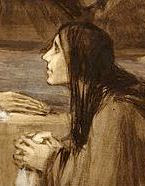
 by Thomas of Celano, a follower of Francis who knew him personally. The biography was completed by 1230, just four years after Francis died. Celano says that when Francis was in his 20s, before embracing a life of poverty, he dearly loved a special male friend:
by Thomas of Celano, a follower of Francis who knew him personally. The biography was completed by 1230, just four years after Francis died. Celano says that when Francis was in his 20s, before embracing a life of poverty, he dearly loved a special male friend:
 by Kittredge Cherry.
by Kittredge Cherry.

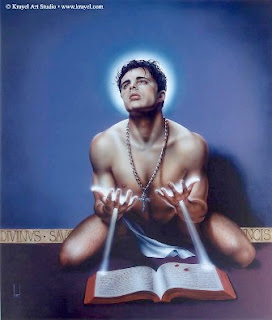





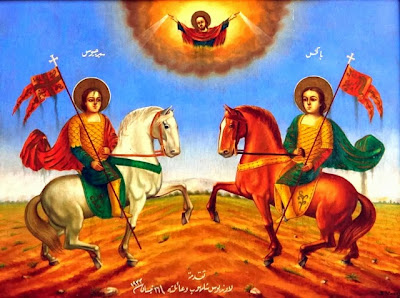
 ”. (The others are
”. (The others are  . The book includes a chapter retelling the love story of Sergius and Bacchus with historical detail.
. The book includes a chapter retelling the love story of Sergius and Bacchus with historical detail.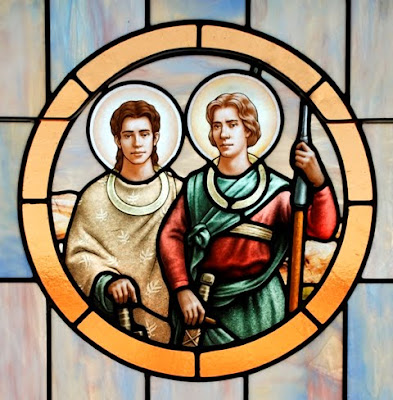



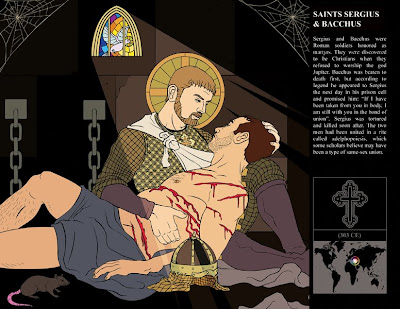

 .
.
 by Kittredge Cherry.
by Kittredge Cherry.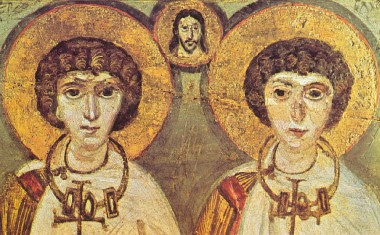




 ,” which he co-authored with Megan McKenna.
,” which he co-authored with Megan McKenna. 

 .” For more about Mead and his art, see my previous post “
.” For more about Mead and his art, see my previous post “

 ” and the “
” and the “ ” with Sam Waterson and Stockard Channing as the grieving parents.
” with Sam Waterson and Stockard Channing as the grieving parents.






 by Donald Boisvert
by Donald Boisvert
























 by Virginia Mollenkott
by Virginia Mollenkott by Justin Tanis
by Justin Tanis by Leanne Tigert (editor)
by Leanne Tigert (editor) (video)
(video)



 ” (2008) and “
” (2008) and “ ” (1984), as well as the book “
” (1984), as well as the book “ ” by Randy Shilts.
” by Randy Shilts. ” by Robert Lentz and Edwina Gateley.
” by Robert Lentz and Edwina Gateley.


 ” by Henri Bechard, S.J.)
” by Henri Bechard, S.J.)


 . With honesty and grace, the film examines the arrival and impact of AIDS on San Francisco, revisiting the devastation of a gay generation lost to AIDS. For me everyone in the movie looked like someone I knew. ALL the faces were familiar! Watching it is both heartbreaking and inspirational.
. With honesty and grace, the film examines the arrival and impact of AIDS on San Francisco, revisiting the devastation of a gay generation lost to AIDS. For me everyone in the movie looked like someone I knew. ALL the faces were familiar! Watching it is both heartbreaking and inspirational. , edited by Letty Russell.
, edited by Letty Russell. :
:

